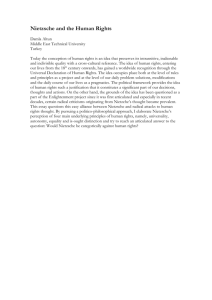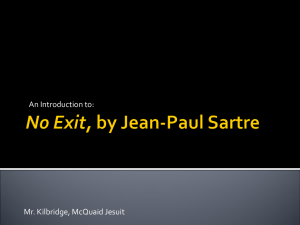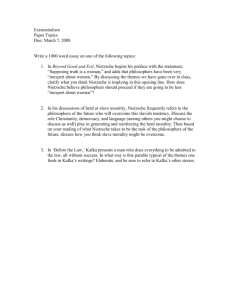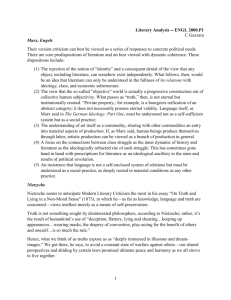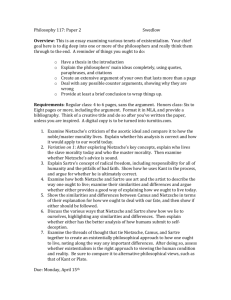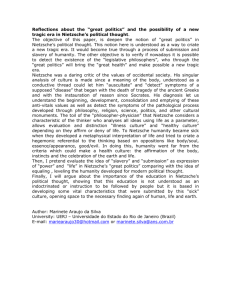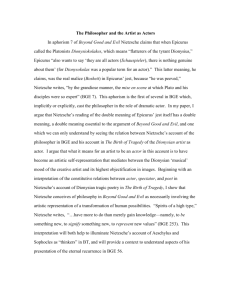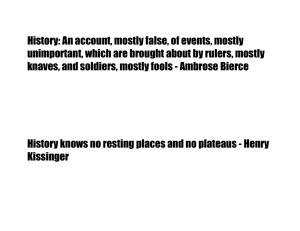nietzsche-essay.doc
advertisement
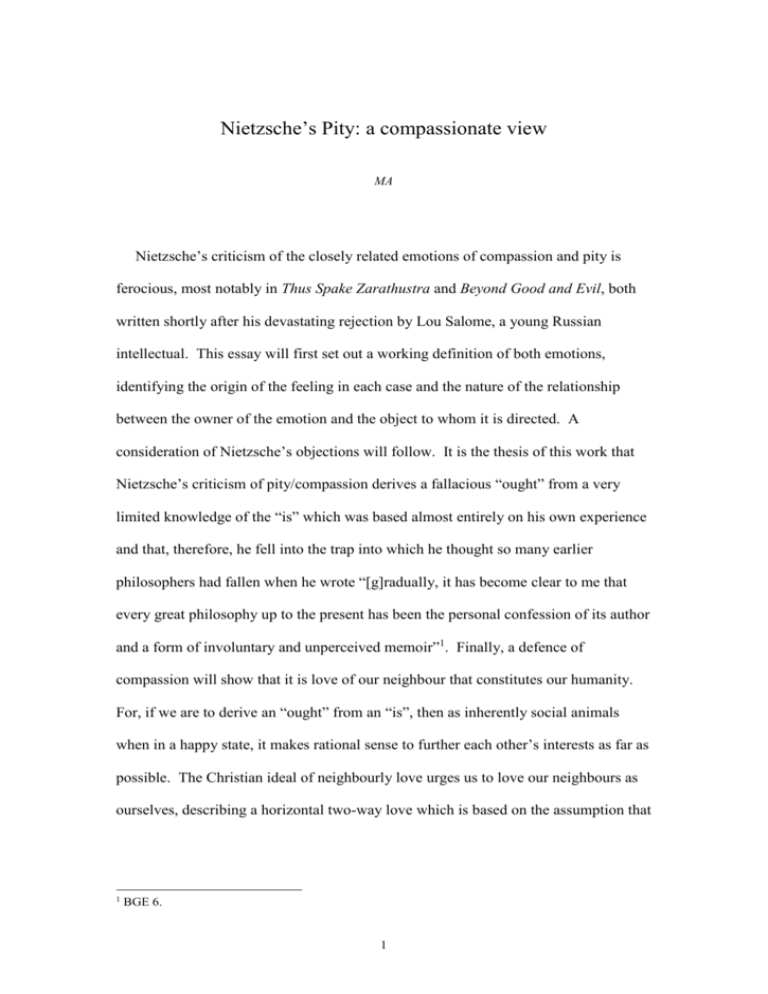
Nietzsche’s Pity: a compassionate view MA Nietzsche’s criticism of the closely related emotions of compassion and pity is ferocious, most notably in Thus Spake Zarathustra and Beyond Good and Evil, both written shortly after his devastating rejection by Lou Salome, a young Russian intellectual. This essay will first set out a working definition of both emotions, identifying the origin of the feeling in each case and the nature of the relationship between the owner of the emotion and the object to whom it is directed. A consideration of Nietzsche’s objections will follow. It is the thesis of this work that Nietzsche’s criticism of pity/compassion derives a fallacious “ought” from a very limited knowledge of the “is” which was based almost entirely on his own experience and that, therefore, he fell into the trap into which he thought so many earlier philosophers had fallen when he wrote “[g]radually, it has become clear to me that every great philosophy up to the present has been the personal confession of its author and a form of involuntary and unperceived memoir”1. Finally, a defence of compassion will show that it is love of our neighbour that constitutes our humanity. For, if we are to derive an “ought” from an “is”, then as inherently social animals when in a happy state, it makes rational sense to further each other’s interests as far as possible. The Christian ideal of neighbourly love urges us to love our neighbours as ourselves, describing a horizontal two-way love which is based on the assumption that 1 BGE 6. 1 we first love ourselves. Nietzsche did not love himself. You have to first love yourself before you are charged with loving others. Martha Nussbaum in her article, ‘Pity and Mercy: Nietzsche’s Stoicism’2, adopting a classical philosophical analysis, contends that the cognitive structure of compassion/pity rests upon three key beliefs which must be present for the emotion to be experienced – first, that the suffering is significant, not trivial; secondly, that the suffering occasioning pity/compassion is not the pity/compassion-object’s own fault; thirdly, that there is a potential for the pity/compassion-owner to experience the same suffering3. In relation to the third belief she argues that it is only possible to hold this belief if some sort of community between the pity/compassion-owner and the pity/compassion-object is acknowledged and that without the sense of commonness, indifference is inevitable. What seems evident from her analysis is that, in the case of all three beliefs, there is an essential subjective element: it must be suffering which the pity/compassion-owner subjectively finds significant, guilt or innocence of the pity/compassion object is determined subjectively by the pity/compassion-owner and the pity/compassion-owner must recognise a subjective potential to be affected in the same way as the pity/compassion object. Pity/compassion tends, therefore, towards a communality of virtues or ethical code if it is to be potentially two-way in a horizontal arrangement. I will only feel compassion for you at the same time as you feel compassion for me if we agree on what constitutes significant suffering, if we agree on where responsibility for the suffering lies, and if we both agree on the potential for our own suffering. Nussbaum goes further in relation to this last point; she says that Nussbaum, Martha C, ‘Pity and Mercy: Nietzsche’s Stoicism’ in Schacht, Richard (ed), Nietzsche, Geneaology, Morality: Essays on Nietzsche’s Geneaology of Morals, University of California Press, 1994. 3 Nussbaum, ibid, fn 2, at 141. 2 2 the position of the pity/compassion-owner is akin to that of the party in the ‘original position’ in Rawls’s theory of justice4. We will return to Nussbaum’s analysis shortly. Compassion and pity are often used interchangeably, or pity is used as shorthand for a ranges of emotions which encompass pity as well as compassion. Both emotions are affective modes of interpersonal communication. Upon closer examination, however, it appears that the two emotions are different in significant respects. For the purposes of this essay, “compassion” will be understood to be the result of a “horizontal” relationship between the owner of the emotion and its object, both having equal status, whilst “pity” is conceived of creating a “vertical” relationship between the owner of the emotion and the object, the owner being in some measure superior or more powerful than the object on whom the emotion is focussed (Fig 1). In both cases the emotion is in response to a stimulus which often occurs in relation to the object without the object’s cognisance, although this is not always the case5. In both cases the emotions are silent and unfelt by the object unless they provoke actions which have a direct bearing on the object. To the extent that they are silent, they may both be said to be useless in relation to the object. Notwithstanding their apparent shared lack of utility in relation to the object, their impact on the owner and the object of the emotion is noticeably different. Particularly with regard to the object, the impact will depend on the object’s own subjective assessment of the emotion being directed toward him by the person feeling pity/compassion. It is possible for the object to mistake compassion for pity (and vice versa, although this seems less likely) 4 p143. We feel compassion, for example, for the England football player we watch on television who fails to score with the final shot in a penalty shoot-out, as a result of which his team is eliminated from the international competition. He is not aware of our compassion. 5 3 and to see himself as a pity-object as a result, when the pity/compassion-owner intended him to be a compassion-object. It is suggested that it is love which motivates the translation of compassion into visible actions, whilst it is often guilt which motivates the translation of pity into visible actions. We shall now turn to the two emotions as they are experienced by the owner and the object (compassionowner/compassion-object and pity-owner/pity-object). Compassion The compassion-owner experiences a positive “going out” towards the compassion-object, a feeling commonly called love. As such it is more likely to enlarge the compassion-owner rather than diminish him. Meanwhile, the compassionobject (presuming he is aware of the compassion owner’s compassion) feels loved by an equal, which is a positive affirming feeling inclining toward and reinforcing selflove. The compassion-owner also appears to be more generous than Nussbaum’s analysis would suggest, in that whilst the first belief (substantial not trivial suffering) may be more or less true in relation to compassion, compassion, being an aspect of love, appears to be forgiving and generous and to be possible even where the suffering is occasioned by the fault of the compassion-object himself. Nor need the potential exist for the compassion-owner to experience the same suffering, though the presence of such a potential may increase the degree of compassion felt. At a minimum, all that is required is that the compassion-owner witness the suffering of the compassion-object and know that it is real. Thus a well-fed citizen of a Western democracy may feel compassion for a starving child in a famine-struck developing country even though there is no realistic potential of the well-fed citizen ever starving 4 but it is more likely that a mother with children may feel compassionate for a recently bereaved mother of a similar age. The degree of identification with, the proximity to, and the degree of suffering of the compassion-object all tend towards a more intense experience of compassion. A sense of commonness heightens the feeling, but is not a strictly a prerequisite unless that commonness is reduced to its most basic level – the frail humanity we share. Pity In contrast, the pity-owner experiences at the same time a sense of superiority since he is above the pity-object, and a pulling-down towards the pity-object, by the pity-owner. Nietzsche described it thus from the viewpoint of the pity-owner: “Pity is opposed to the tonic passions which enhance the energy of the feeling of life: its action is depressing. A man loses power when he pities. By means of pity the drain on strength which suffering itself already introduces into the world is multiplied a thousandfold.” 6 For Nietzsche, pity is further suffering, adding to an already intolerable burden. It is an attempt by the pity-object to reduce the pity-owner to the same level and must be resisted. It is a recognition that the pity-owner is part of the suffering of the pityobject and is accompanied by a “hoarse, groaning, genuine note of self-contempt”7. For the pity-object, pity is also a source of pain since it serves to emphasise his own position of powerlessness, confirming his inferiority in relation to the superior pityowner. Orthodox transactional psychology, such as that put forward by Stephen 6 The Antichrist, Prometheus Books, New York, 2000, translated by Anthony M Ludovici. An alternative translation is given by Walter Kaufmann in The Portable Nietzsche, Penguin, 1954. This translation better emphasises the connection obvious to a German speaker between suffering generally and “Mitleid” or “suffering with” which translates as pity: “We are deprived of strength when we feel pity. That loss of strength which suffering as such inflicts on life is still further increased and multiplied by pity.” 5 Karpman in his "Drama Triangle"8, has a similar hierarchical structure (Fig 2) where victim equates to pity-object and rescuer equates to pity-owner. The “victim” position is an uncomfortable position to be in (arguably because it defeats the will to power) and a move along the axis towards the “persecutor” role, forcing the “rescuer” down into the victim position, is a commonly observed phenomenon that is consistent also with the views of Rollo May which are discussed later. We might, at this point, maintaining that it is valid to distinguish between compassion and pity, agree with Nietzsche that pity has little to recommend it, but to reserve our position in relation to compassion. Nietzsche, however, did not make such a nice distinction. He used different words to convey the different meanings but not consistently so. He used the German “Mitleid” (suffering-with), useful for its component element of suffering, but also the more neutral “Mitgefühl” (feelingwith)9. The German “Mitleid” then, as now, appears to be equivalent to compassion, carrying with it no pejorative sense in everyday usage10. Indeed, when Nietzsche wanted to speak of pity – emphasising the condescension involved - he often chose to use the English word “pity” or the French “pieté” from which the English is derived11. 7 BGE, 222. For a more detailed account of the various roles typically played by the victim, see Forest, Lynne, ‘The Faces of the Victim’, http://lynneforrest.com/articles/fov.html. The triangle was originally described in an article Karpman, S, ‘Fairytales and Script Drama Analysis’, Transactional Analysis Bulletin, 7, No 26, (April 1968) P. 39-43. (http://www.itaa-net.org/TAJNet/articles/karpman01.html). 8 In BGE 202, Nietzsche uses both words: “aber ebenso Eins in der Religion des Mitleidens, im Mitgefühl, soweit nur gefühlt, gelebt, gelitten wird […]; Eins allesammt im Schrei und der Ungeduld des Mitleidens, im Todhass gegen das Leiden überhaupt, in der fast weiblichen Unfähigkeit, Zuschauer dabei bleiben zu können, leiden lassen zu können”, in a passage which links pity/compassion with “feminine” (“weiblichen”) weakness and which deplores the Christian slave or “herd-animal” morality. (“… but equally at one in the religion of pity, in sympathy with whatever feels, lives suffers […] at one, one and all, in the cry and impatience of pity, in mortal hatred for suffering in general, in their almost feminine incapacity to remain spectators of suffering, to let suffer …”) 10 The “vertical” sense implicit in “pity” is more effectively conveyed in German by the expression “Er tut mir leid” (I am sorry for him). 11 Nussbaum, Martha C, ibid, fn2, at p140. Her article contains a more detailed account of the various words used by Nietzsche to convey compassion/pity, though she makes no reference to “Mitgefühl”. 9 6 Both words have a religious origin implying an obligation or duty which arises in the heart of the owner of the emotion. When reading Nietzsche’s works in translation, it is impossible to know which of the many ways of conveying pity/compassion he chose at a particular point (since “pity” is used to translate several different words), nor is it ever possible (translation or not) to be certain whether the choice of word had any particular significance. Martha Nussbaum’s compromise in her article, ‘Pity and Mercy: Nietzsche’s Stoicism’, is to use only “pity”, despite its negative overtone, ignoring the fact that the word that Nietzsche most commonly uses (“Mitleid”) is more readily understood as compassion. The complex term pity/compassion is preferred here. According to Nussbaum, academic attitudes to Nietzsche’s arguments against pity fall into two camps in which he is either characterised either as a cruel “boot-in-theface” fascist or as a noble apologist for a return to true Christian morality12, neither of which she believes to be accurate or to do justice to his position. For her, Nietzsche’s approach is in the classical Stoic tradition but is neither innocuous nor uncontroversial in that it “assails[s] the roots of the deepest sort of human love”13: but that is to run ahead of an account of her deconstructive analysis. Nussbaum detects six prominent arguments put forward by Nietzsche against compassion: Walter Kaufmann is an example of a supporter of the latter view. He says “In the Gospels, too, there is much that seems close to Nietzsche in this respect. It may well be that any ethic in which the highest good is the individual’s state of being – whether that be self-control, self-perfection, or the attainment of the Kingdom of God – entails some deprecation of overly great concern about others” (Kaufmann, Walter, Nietzsche: Philosopher, Pyschologist, Antichrist, Princeton, 1974, p363). 13 p140. 12 7 1. . 2. Pity/compassion is an acknowledgement of weakness in the pity/compassionobject Pity/compassion is an acknowledgement of weakness and insufficiency in the pity/compassion-owner. 3. Pity/compassion is egoistic in that, even if only subconsciously, it is an attempt to get rid of the pity/compassion-owner’s suffering and is based on existential fear. 4. Pity/compassion simply increases the amount of suffering in the world since the suffering of the pity/compassion-owner is added to the suffering of the pity/compassion-object. 5. The causes of pity/compassion are good for the pity/compassion-object. 6. Pity/compassion is an aspect of revenge and cruelty. The fifth argument is a view particular to Nietzsche and difficult to accept unconditionally. It derives from his core belief that “what does not kill me makes me stronger”14 coupled with a masochistic desire to submit himself to tests of “suffering, desolation, sickness, ill-treatment, indignities … profound self-contempt, the torture of mistrust, the wretchedness of the vanquished”15 as the only means by which to refine his character. The sixth somewhat-complicated argument depends on an acceptance of Nussbaum’s third cognitive belief in the common vulnerability of the pity/compassion-owner and the pity/compassion object. If we - those experiencing pity/compassion - accept that we too might suffer like the pity/compassion-object then we are likely to be filled with envy and resentment and to retaliate against those who cause the pity/compassion-object to suffer, since they, potentially, could cause our own suffering. The argument will be considered further below in relation to Rollo May’s view on the cause of violence. 8 Nussbaum’s concludes her article in saying that Nietzsche’s dislike of pity is, in effect, inauthentic in that (she maintains) he advocates a dual contradictory approach to life - on the one hand stoic, solitary, self-contained, needing no other person and ignoring all slights, and, on the other hand, romantic, going out on a limb, risking everything to shout “Yes”. For all his words, she argues that Nietzsche was a comfortable, bourgeois, armchair philosopher who took refuge behind a selfprotective stoicism which inoculated him against the “engagement” that he advocated and which we see subsequent existentialists embrace and which, crucially, shut him off from the hurt and fear that accompany loving attachments (and which, we would add, are the essential basis for compassion). It is difficult to accept her conclusion without reservations because it is not entirely borne out by what we know of Nietzsche’s experience. Nietzsche did on several occasions open himself to the possibility of love, notably in his relationship to Lou Salome, but his experience was so devastating that he subsequently undertook to avoid it at all costs16. Arguably, such avoidance (or certainly reluctance) is a normal human reaction to a deeply wounding stimulus, and - if he constructed a self-referential ethic that bolstered his own protection mechanisms - he was doing no more than is essential to maintain his 14 15 TOTI, Maxims and Arrows, 8. WP 910, 1887 in Nussbaum, Martha C, ibid, fn2, p153. 16 Nietzsche was introduced by his friend Paul Ree to Lou Salome, and fell in love with her, seeing her as a kindred spirit. He wrote to her “We have been talking ourselves absolutely to death … Strange how in the course of our conversations we manage inadvertently to descend into abysses and those dizzying places people go all alone to gaze down into the depths. We have always chosen the mountain goat paths. If somebody had listened in on our conversations, he would have thought that two devils were talking” (15, 125; Chronik. In Safranski, Rüdiger, Nietzsche: A Philosophical Biography, Granta, 2002. This book has a chapter on Lou Salome and Nietzsche’s quest for intimacy). He was broken-hearted when she refused his proposals of marriage and went to live with Paul Ree. He tried removing his pain with large amounts of drugs and wrote the pair many unfinished letters declaring himself “head-sick and half-crazy”. In December 1882, a few months after his rejection by Salome, he wrote to a friend “This last bite of life was the hardest I’ve chewed yet, and it is still possible that I will choke on it. I have suffered from the insulting and excruciating memories of this 9 self-esteem, indulging in typically human self-justification. It is an irresistible conclusion that had Nietzsche’s experience of relationships been more rewarding, he would not have espoused such an austere, love-less ethic and neither would he have rejected compassion along with pity. There is, however, some evidence that Nietzsche expressed compassion as we have defined it (we cannot, of course, be sure that he felt compassion17). Nietzsche wrote to Paul Ree, his friend and soon-to-be competitor for the affection of Lou Salome, in 1881, a year before Nietzsche’s rejection by Lou Salome: “I am overcome constantly by misery to hear that you are suffering, that you miss something, that you have lost someone; to me, though, suffering and doing-without are natural and not, as with you, unnecessary and unreasonable elements of existence”18. Signficantly, the experience which finally drove him to madness seems to include an experience we would usually describe as compassion. In 1889 he witnessed a carriage driver beating a horse. He threw his arms around the horse’s neck: “He collapsed in compassion with the horse”19. He never recovered from the collapse and was discovered a few days later by a friend who reported “I see Nietzsche huddled up reading in the corner of a sofa … the incomparable master of expression is incapable of conveying even the delights of his merriment in anything but the most trivial expressions or by dancing and jumping about in a comical manner”20. Nietzsche needed care for the rest of his life. He lived until August 1900 in clinics or with his mother until she died. summer as from a madness… If I do not discover the alchemist’s trick of turning even this – dung into gold, I am lost” (in the introductory Note to The Genealogy of Morals, Dover Thrift Editions, 2003). 17 Nietzsche wrote in HATH, 50 that “Of course one ought to express pity, but one ought to guard against having it”. 18 Written end of August 1881 from Sils-Maria. In Salome, Lou, Nietzsche, University of Illinois Press, 2001, at pp12-13. 10 Lou Salome had, by Nietzsche’s own account, been allowed to see him more closely than anyone else. Because he gave more of himself to her than anyone else, he found it almost impossible to recover from her rejection of him and Thus Spake Zarathustra was the immediate product of his grief, begun two weeks after he had written to his friend, Franz Overbeck, of the need for a “bulwark against the unendurable”21, and finished ten days after that. Salome, in her book on Nietzsche written in 1894 but not translated into English until 1988, draws a picture of a man intent on leading a solitary life of self-exploration followed by self-conquest or, as he described himself, “a wrestler who has too often wrestled himself to the ground, who has too often braked him own victory over himself”22 at the base of which fight was, according to Salome, the riddle of his own existence: “The more profoundly he understood himself, the more uninhibitedly his entire philosophy became a vast reflection of his self-portrait”23. His view that pity injured those who bestowed pity and those upon whom it was bestowed in equal measure was not borne out by his own actions necessarilyt, but was aspirational rather – he wanted to be beyond pity, both as pity-owner and pity-object. It is possible to conceive that someone who knew himself to be the object of so much pity would be spurred by the will-to-live to make just such a brave, poignant attempt to haul himself out of the abyss of depression and pain where he spent his life, to escape from his own perception of himself as a pity-object. Nietzsche’s goal was to find a reason for living, since “[h]e who has a why to live can bear almost any how”24. 19 Safranski, fn 16, p316. The friend was Jacob Burckhardt and the account is included in Safranski, ibid, p371. 21 From the same letter mentioned in fn 16, but quoted in Safranski, ibid, at 257. 22 BGE 5, in Salome, fn 18 at p15. 23 Salome, ibid, p17. 24 TOI, Maxims and Arrows, 12. 20 11 This “Why” was different for each man: “ “This is my way; where is yours? – thus I answered those who asked me “the way”. For the way – that does not exist”25. Nietzsche’s way out of depression and pessimism lies in the “overcoming of morality”26, that is, the morality of his time, the “slave morality”. “There is nothing for it: the feelings of devotion, self-sacrifice for ones’ neighbour, the entire morality of self-renunciation must be taken mercilessly to task and brought to court”27. For Nietzsche the way lay in “self-overcoming”, in becoming the “overman”. That he chose this route is probably an indication of a tendency in himself to self-pity. Richard Schacht says, in his book on Nietzsche, that “[Nietzsche’s] suffering had no more poignant application in his own case than with respect to the suffering he knew so well” and that “Nietzsche’s critique of pity is above all an attack upon the tendency sufferers have (…) to be overwhelmed by their own suffering … and in their preoccupation with it to take it to matter more than anything else”28. The Overman or Ubermensch is first developed as an idea in Thus Spake Zarathustra and embroidered in Beyond Good and Evil, written immediately afterwards, and in The Will to Power. In Thus Spake Zarathustra Zarathustra says: “I teach you Superman. Man is something that should be overcome”29. This overcoming cannot be achieved with neighbourly love or compassion: 25 TSZ, Part III, on the Spirit of Gravity, 2. BGE 32. 27 BGE 33. 28 Schacht, Richard, Nietzsche, Routledge, 1983, pp 458-9. 29 TSZ, Prologue, 3. 26 12 “You crowd together with your neighbours and have beautiful words for it. But I tell you: Your love of your neighbour is your bad love of yourselves. You flee to your neighbour away from yourselves and would like to make a virtue of it: but I see through your ‘selflessness’.” 30 Nietzsche’s call was to re-evaluate ones values, according to the new morality of the overman, which was a return to the old morality of the aristocratic elite. According to Nietzsche’s account in The Genealogy of Morals, the ideas of “good” and “bad” grew out of distinctions that were originally made between the actions of the aristocratic elite on the one hand (“good”), and the behaviour of the “low-minded, vulgar, and the plebeian” (“bad”) on the other hand. Originally, he says, those with noble, aristocratic souls had no need of pity (and it was, by implication, “bad”), but “it required the slave revolt in morality for qualities like pity, humility and patience to be transformed into the ‘good’”31 - a revolt that Nietzsche says began only during the Thirty Years’ War (1618-1648)32. Nietzsche did not see himself as alone in the deprecation of pity. For him, whilst the morality of pity was a scourge of modern European civilisation, earlier philosophers such as Plato, Spinoza, La Rochefoucauld and Kant had been “unanimous as to the worthlessness of pity33. His urges a return to the master morality of noble aristocrats and sanctions pity only in two instances. First, when it is the pity of those, like him, who have insight into man’s true condition. This is “our pity” which is contrasted with “your pity”. The former (“our pity”) is “a more elevated, more farsighted pity”, more usually assigned to a God or king, which sees TSZ, Of Love of One’s Neighbour. Spinks, Lee, Friedrich Nietzsch, Routledge Critical Thinkers, 2003, p96. 32 GOM, Essay 1, 2-4. 30 31 13 how the slave-class’s pursuit of hedonism, pessimism, utilitarianism and eudaemonism is diminishing man. The latter (“your pity”) has as its goal the abolition of suffering, ignorant that it is precisely great suffering which has been responsible for every “great elevation of man”34 and ignorant of the role it places in increasing the suffering it seeks to eliminate. In Beyond Good and Evil we learn that the higher man is aristocratic, independent, a free spirit who has re-evaluated his values and identifies with the values of classical Roman and Greek society when pity was neither good nor bad, who is destined for command, lives behind a mask, evades communication, and lives in “a secret citadel where he is set free from the crowd”35. Nietzsche is under no illusions that the truth about historical aristocratic societies is unpalatable to most (“Human beings whose nature was still natural, barbarians in every terrible sense of the word, men of prey who were still in possession of unbroken strength of will and lust for power”36); but, yet, these aristocrats were “more whole human beings”. Secondly, pity is appropriately felt towards women. Men and women are, according to Nietzsche, destined to the “most abysmal antagonism and the necessity of an eternally hostile tension”37. For him a true man can only conceive of woman as a “possession, as property with lock and key, as something predestined for service”38. He pours scorn on the defeminizing of the “weak sex” that is occurring in his society, when women unlearns her fear of men, degenerates, and becomes increasingly incapable of “her first and last profession, which is to bear strong children”, casting 33 GOM, Preface, 5. Space precludes a consideration of the truth of his statement here. BGE, 225. 35 BGE, 26. The other descriptions are from various paragraphs of BGE. 36 BGE, 257. 37 BGE, 238. 38 BGE 238. 34 14 off her “subtle cunning humility”, fragmenting her will, losing her fear-inspiring “tiger’s claws” that hide within the glove39. For this animal, this cat, “woman” is “more afflicted, more vulnerable, more in need of love and more condemned to disappointment than any other animal. Fear and pity: it is with these feelings that man has hitherto stood before woman, always with one foot in tragedy, which lacerates as it delights” 40. In The Will to Power, Nietzsche’s identification of pity/compassion as a “female virtue” is placed beyond doubt: “Finally: woman! One-half of mankind is weak, typically sick, changeable, inconstant – woman needs strength in order to cleave to it; she needs a religion of weakness that glorifies being weak, loving, and being humble as divine: or better, she makes the strong weak – she rules when she succeeds in overcoming the strong. Woman has always conspired with the types of decadence, the priests, against the “powerful,” the “strong”, the men -. Woman brings the children to the cult of piety, pity, love: - the mother represents altruism convincingly”41. Only in relation to the friend does Nietzsche see any place for compassion42, thereby confirming, perhaps, our definition of compassion as occurring only between equals. For the friend is the rare equal, according to Nietzsche, and even in relation to the friend “[c]ompassion for the friend should conceal itself under a hard shell and you should break a tooth on it. That way it will have delicacy and sweetness”43. Upon the friend, he writes in The Will to Power, one would wish, in any event, amongst other things, suffering, being forsaken, humiliation, profound self-contempt. For the friend “I have no pity … because I wish them the only thing that can prove today whether one is worth anything or not – that one endures”44. The manuscript to The Will to Power continues “I have not yet got to know any idealist”, suggesting that he has yet to meet a “friend” prepared to live up to his standards of friendship. It was an 39 BGE 239. BGE 239. 41 WTP 864. 42 See Kaufmann, fn 12, for an indulgent account of Nietzsche’s approach to pity and the value of elitist male friendships. 43 TSZ, 1, 14. 40 15 exacting standard indeed. Friendship with a women is not possible45. Nietzsche’s idea of loving friendship which was “above all of its pity; for it still wants to create the beloved”46 was based on a irreducible assumption that suffering was an inseparable part of life. Even if the assumption is accepted as true, would not compassion mitigate the sentence? It is clear, to summarise, that for Nietzsche pity/compassion imposes a hierarchical structure on the pity/compassion-owner and pity/compassion-object which can only be sanctioned when there is justification for such a hierarchical relationship to exist, such as between man and woman, or between the aristocratic overman and ordinary mortals. In other circumstances, compassion/pity is wrong for the reasons which Nussbaum summarises. If we restrict our agreement with Nietzsche to “pity” alone, we will find convincing support amongst modern-day psychologists for many of those arguments. In relation to the first and sixth arguments (taken together) Nietzsche wrote that rather than seeing pity as an emotion that originates in the man who pities, we should be warned that those whom we pity have often set out to make us feel pity for them: “The pity that the spectators then express consoles the weak and suffering, inasmuch as they see that, despite all their weakness, they still have at least one power: the power to hurt. When expressions of pity make the unfortunate man aware of this feeling of superiority, he gets a kind of pleasure from it; his self image revives; he is still important enough to inflict pain on the world. Thus the thirst for pity is a thirst for self-enjoyment, and at the expense of one’s fellow men”47. 44 WTP 910. TSZ, 1, 14. 46 TSZ, 2, 3. 47 HATH, 50. 45 16 Nietzsche says that Merimée is right when he says “Sachez aussi qu’il n’y a rien de plus commun que de faire le mal pour le plaisir de le faire” (Know that nothing is more usual that to do harm for the pleasure of doing it)48. Rollo May, in his seminal and authoritative work on the causes of violence, Power and Innocence, cautions against seeing power only in its negative form of violence. He argues that Nietzsche’s will to power is better understood as self-realisation and self-actualisation49: violence is the result of those who are powerless or weak trying to assert themselves in the only way they think they can – by hurting others. Otherwise put, violence is a “potentially constructive” force, turned awry. He argues that humans need to know that they are significant and, further, that deeds which hurt others intentionally or knowingly are often an expression of different, neurotic forms of power which are a substitute for significance: “Deeds of violence in our society are performed largely by those trying to establish their selfesteem, to defend their self-image, and to demonstrate that they, too are significant. Regardless of how derailed or wrongly used these motivations may be or how destructive their expression, they are still the manifestations of positive interpersonal needs” Holding that “[v]iolence and communication are mutually exclusive”50 Rollo May argues that personal power or self-actualisation is necessary for communication, and, further, that it is also a prerequisite for compassion: “Compassion requires that one have some security, some position of power from which he can give concern to another.” Since compassion is a form of love, there is an intrinsic relationship between love and power51 in the sense of self-affirmation. Compassion has power as a pre-requisite but is also empowering: “Compassion is the name of that form of love 48 HATH, 50. May, Rollo, Power and Innocence, A search for the sources of violence, Norton, 1972, p20-23 and 35-39. 50 ibid, p65. 49 17 which is based on our knowing and our understanding each other… Compassion arises from the recognition of community…Compassion is the tie felt for another not because he “fulfils his potentialities”… Compassion is felt toward another as much because he doesn’t fulfil his potentialities – in other words he is human […] forever engaged in the struggle between fulfilment and nonfulfilment… As Jacob Bronowski says: “We are all lonely … We’ve learnt to pity one another for being alone. And we’ve learnt that nothing remains to be discovered except compassion”52. For May, compassion is the acceptance of our humanity with all its potential for evil: “Compassion occupies a position opposite to violence; as violence projects hostile images on the opponent, compassion accepts such daimonic impulses in one’s self. It gives us the basis for judging someone without condemning him”53. Finally, Rollo May offers a vision of his new ethic which he describes as an “ethic of intention” and which is based on each man assuming responsibility for the effects of his actions. His critique of the oft-glorified unadulterated will to power is that it lacks “authentic empathy” and understanding of the powerless which is the beginnings of compassion, pity and charity54. Richard Holloway, formerly Anglican bishop of Edinburgh and Professor of Divinity, and now a controversial (some say “heretical”) writer on contemporary Christianity, frequently uses Nietzsche’s work to illustrate his own arguments. In his discourse on forgiveness55, he points to the period that heralded the birth of ethical 51 ibid, p248. Bronowski, Jacob, The Face of Violence: An Essay with a Play, Cleveland: World, 1967, p161-162 in May, fn 49, p252. 53 ibid, p252. 54 ibid, p258. 55 Holloway, Richard, On Forgiveness, Canongate, Edinburgh, 2002. 52 18 monotheism and the emergence of the conscience that marked the end of the undisputed reign of the powerful over the powerless and which he dates to the Eighth Century BC56. Holloway comments “in an aimless universe the emergence of compassion […] is an evolutionary miracle, a shock as remarkable as the sudden jump into life of the primal gene”57. For Holloway compassion is akin to grace or mercy and precedes forgiveness with its transforming power. Perhaps this is the strongest argument for compassion, that actions motivated by compassionate love and not by pity, recognising as they do a communality between the compassion-owner and the compassion-object may lead the pity/compassion-object to forgive himself for his own self-loathing and empower him to view himself not as a pity-object using violence as a will to power. Holloway ends his book on forgiveness with a chilling account of a failure to show compassion and its disastrous consequences. Churchill took no delight in the end of the First World War, knowing that Germany was left starving. Having compassion for his enemies, he asked for ships to be allowed to take emergency provisions to Hamburg, but was rebuffed. Germany had been brought to her knees and was kept there. A German non-commissioned soldier heard the news of Germany’s defeat whilst in hospital recovering from temporary blindness following a gas attack. Six years later Hitler, for it was he, wrote, remembering the night he learnt of the defeat: “I knew that all was lost. Only fools, liars and criminals could hope for mercy from the enemy. In these nights hatred grew in me, hatred for those responsible for this deed … The more I tried to achieve clarity on the monstrous events of this hour, the more the shame and indignation and disgrace burned my brow. What was all the pain in my eyes compared to this misery? In the days that followed, my own fate became known to me … I resolved to go into politics” 58. 56 ibid, p25. Nietzsche agrees, BGE 195. ibid, at p22. 58 In Manchester William, The Last Lion: Winston Spencer Churchill, Visions of Glory 1874-1932, Little, Brown and Company, Boston, 1983 pp650-651 quoted in Holloway, ibid, at pp91-92. 57 19 Where compassion becomes pity, where the owner/object relationship becomes vertical, there is the risk that actions borne of pity can disempower still further those who already feel disempowered. Much has been written about the danger of “rescuing” tendencies and co-dependency 59 which arguably damage as much as they purport to help60. It is difficult to be on the receiving end of compassion even61, and distasteful to be on the receiving end of pity. It is consistent with May’s thesis and Nietzsche’s position to argue that man’s nature encompasses the capacity for both good and evil, but, developing the argument with May only, that the evil or violence only erupts when man finds himself in a position of powerlessness. Postulating then, that this disempowered position is where Nietzsche found himself (for a variety of reasons – upbringing, physical characteristics, lack of successful relationships, debilitating headaches and deteriorating eyesight), then it is not impossible that Nietzsche would seek to console himself by asserting that man’s true nature is Dionysian62 and that the highest and noblest man possesses “a trait of cruelty, a tigerish lust to annihilate”. May would probably argue that those desires are present in all men (and it is making that acknowledgement that one understands and becomes capable of compassion, feeling on a par with others) and are demonstrated by the will to power, but that that once the desire for power is correctly satiated by self-affirmation, there is no longer any need 59 Norwood, Robin, Women Who Love Too Much, Arrow, 1985, is a well-known text and contains a bibliography of other sources. 60 For a feminist critique of these which argues that we have been encouraged to view as damaging qualities which are inherently feminine and to exalt traditional male characteristics, see Tavris, Carol, The Mismeasure of Woman, Touchstone, Simon &Schuster, New York, 1992, esp 170-207. 61 C S Lewis, in The Four Loves (HarperCollins, 1960) gives an extreme example of a spouse struck down by an incurable disease which renders him “useless, impotent, hideous, disgusting” but yet is loved compassionately by his wife, with charity. He comments “In such a case to receive is harder and perhaps more blessed than to give”. 62 For a short explanation of this term and its antithesis, see TOI, 10. 20 for the jealousy, hatred and envy which spurs men on otherwise and which Nietzsche so much admired in the mythical Greek warrior63. Nietzsche may have made out his case on pity, but is unconvincing if “Mitleid” is given its usual translation of compassion and if his arguments are taken (as they must be) to include compassion as well as pity. It is impossible to answer Nietzsche’s arguments against pity/compassion with logic. Any attempt to defend a morality of compassion or neighbour love will inevitably be met with a charge that one is conforming to the herd-mentality or, worse, espousing a feminine virtue. The only answer is an intuitive one that relies on love as the basis for compassion and outwits Nietzsche, who is left having to face his own statement that love is “beyond good and evil”64 and that compassion can be, therefore, neither good nor bad. Even Bertrand Russell was confounded by his arguments. Russell asks whether if Buddhism or Christianity with its basis in universal sympathy faced Nietzsche’s complete absence of sympathy, either could produce any argument that ought to appeal to the impartial listener. Russell favours Buddha but cannot prove that he is right: “I dislike Nietzsche because he likes the contemplation of pain, because he erects conceit into a duty, because the men whom he most admires are conquerors, whose glory is cleverness in causing men to die. But I think the ultimate argument against his philosophy, as against any unpleasant but internally self-consistent ethic, lies not in an appeal to facts, but in an appeal to the emotions. Nietzsche despises universal love; I feel it is the motive power to all that I desire as regards the world. His followers have had their innings, but we may hope that is coming rapidly to an end65”. Nietzsche, for all his emphasis on the genealogy of words, profoundly misunderstood compassion because he resolutely refused to put himself in the shoes Nietzsche, Homer’s Contest, Five Prefaces to Five Unwritten Books: Fifth Preface. Partially from the translation by Walter Kaufmann on The Nietzsche Channel, www.geocities.com/thenietzschechannel/hc.htm. 64 BGE, 153. 65 Russell, Bertrand, History of Western Philosophy, Routledge, 2000, p739. 63 21 of others, to feel alongside them66 because he refused to see anyone but the (nonexistant) rare friend as his ‘overman’ equal with whom the horizontal reciprocity of compassion could be experienced. His ethic refused compassion and he put himself beyond a loving relationship: “[n]ot to cleave to another person, though he be the one you love most – every person is a prison”67. It is difficult to ignore Nussbaum’s suggestion that fear pushed him into this position, but, if so, it is a fear that is easily understood especially in the context of his struggle with his self esteem following Lou Salome’s rejection of him. Of compassion and pity, it was only pity that he allowed himself the option of feeling, with its concomitant risks. Little surprise then that he hated pity so much: “Where pity and fellow suffering is preached today … the psychologist should prick up his ears: through all the vanity … he will hear a hoarse, groaning, genuine note of self-contempt.”68. Perhaps we can look more kindly on Nietzsche if we see his views as the expression of an essential life force, the will to power, from a man fighting against his seeming lot to be a pity-object by his own account, and if we can acknowledge that we have been informed by hearing his perspective which is shared by many in similar circumstances, and if we can applaud the creative potential of the will behind the apparent cruelty. One can speculate that Nietzsche’s failing went further than an unwillingness to feel compassion in that he was unable generally to feel compassion because he lacked the ability to empathise (though not entirely to sympathise) with others. Nietzsche invariably features in the lists of famous people thought to have had Asperger’s syndrome, for example. Asperger’s syndrome is a form of high-functioning autism which is characterised by a lack of empathy. Professor Simon Baron Cowen, the world expert in Asperger’s syndrome, has developed a theory that it is one extreme – the male end - of the male/female continuum of emotional characteristics. An ability to “schematise” (unavoidably a task of philosophers) lies at the male end of the continuum with its antithesis – the ability to empathise – at the female end. Whilst most people can do both to varying degrees, those with Asperger’s syndrome have a very limited ability to empathise, and thus to feel a wide range of emotions that depend on empathy, such as compassion, gratitude, and, arguably, love. Such emotions may be felt for a very short space of time, when the stimulus is extreme, but cannot be sustained. See Baron-Cohen, Simon, The Essential difference: Men, Women and the Extreme Male Brain, Allen Lane, Penguin, 2003. 67 BGE, 41. 68 BGE 222. 66 22 Bibliography Books Baron-Cohen, Simon, The Essential difference: Men, Women and the Extreme Male Brain, Allen Lane, Penguin, 2003 Gilman, Sander L, Conversations with Nietzsche: A Life in the Words of his Contemporaries, OUP, 1987 Golomb, Jacob, Santiello, Weaver, Lehrer, Ronald (Eds), Nietzsche and Depth Psychology, State University of New York Press, 1999 Holloway, Richard, On Forgiveness, Canongate, Edinburgh, 2002 Kaufmann, Walter, Nietzsche: Philosopher, Pyschologist, Antichrist, Princeton, 1974 Kaufmann, Walter (ed and translator), The Portable Nietzsche, Penguin, 1976 Lewis, C S, The Four Loves, HarperCollins, 1960 Leiter, Brian, Nietzsche on Morality, Routledge, 2002 May, Rollo, Power and Innocence, A search for the sources of violence, Norton, 1972 May, Rollo, Love and Will, Norton, 1969 Nietzsche, Friedrich, The Will to Power, Vintage, 1968 (Translator: Walter Kaufmann) Nietzsche, Friedrich, Human, All to Human, Penguin Classics, 1994 (Translators: Marion Faber and Stephen Lehmann) Nietzsche, Friedrich, Zarathustra’s Discourses, Penguin 60s Classics, 1995 (Translator: R Hollingdale) Nietzsche, Friedrich, The Genealogy of Morals, Dover, 2003 (Translator: Horace B Samuel) Nietzsche, Friedrich, The Antichrist, Prometheus Books, 2000 (Translator Anthony M Ludovici) Nietzsche, Friedrich, Beyond Good and Evil, Penguin Classics, 1990 (Translator: R Hollingdale) Nietzsche, Friedrich, Twilight of the Idols/The Antichrist, Penguin Classics, 1990 (Translator: R Hollingdale) Russell, Bertrand, History of Western Philosophy, Routledge, 2000 Safranski, Rüdiger, Nietzsche: A Philosophical Biography, Granta, 2002 (Translator: Shelley Frisch) Salome, Lou, Nietzsche, University of Illinois Press, 2001 (Translator: Siegfried Mandel) Schacht, Richard, Nietzsche, Routledge, 1983 Schacht, Richard (ed), Nietzsche, Geneaology, Morality: Essays on Nietzsche’s Geneaology of Morals, University of California Press, 1994 Spinks, Lee, Friedrich Nietzsche, Routledge Critical Thinkers, 2003 Tavris, Carol, The Mismeasure of Woman, Simon and Shuster, 1992 23 Articles/Extracts Denneson, Travis J, ‘Nietzsche’s The Antichrist’, www.infidels.org/library/modern/travis_denneson/antichrist.html Forest, Lynne, ‘The Faces of the Victim’, http://lynneforrest.com/articles/fov.html. Karpman, S, ‘Fairy Tales and Script Drama Analysis’, Transactional Analysis Bulletin, 7, No 26 (April 1968) P. 39-43. (http://www.itaa-net.org/TAJNet/articles/karpman01.html). Nietzsche, Friedrich, Homer’s Contest, Five Prefaces to Five Unwritten Books www.geocities.com/thenietzschechannel/hc.htm. (Partially from the translation by Walter Kaufmann) Nussbaum, Martha C, ‘Pity and Mercy: Nietzsche’s Stoicism’ in Schacht, Richard (ed), Nietzsche, Geneaology, Morality: Essays on Nietzsche’s Geneaology of Morals, University of California Press, 1994 Soll, Ivan, ‘Nietzsche on Cruelty, Ascetism, and the Failure of Hedonism’ in Schacht, Richard (ed), Nietzsche, Geneaology, Morality: Essays on Nietzsche’s Geneaology of Morals, University of California Press, 1994 Reference Key BGE = Beyond Good and Evil GOM = The Genealogy of Morals HATH = Human, All to Human TA = The Antichrist TOTI = Twilight of the Idols TSZ = Thus Spake Zarathustra TWTP = The Will to Power 24
